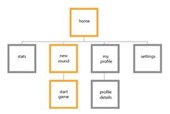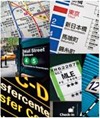As part of the “App to the future” challenge (see details at the end of the post) we’ve conducted Lightning Design Review sessions for a few weeks, and one thing struck me as I was watching: review after review, I could clearly identify some recurring patterns.
So, I asked Senior Interactive Designer, Lincoln Anderson, who hosts the reviews, to analyze common issues he sees and write down the top eight design tips for Windows Phone. Here’s what we came up with.
1. Focus

Write a “best-at” statement that clearly outlines what makes your app great and unique from the rest. Use it as a mission statement that guides design and development. Think about how different types of users will employ your app and focus on the top three “user scenarios” that truly support your best-at statement. Make these user experiences truly stellar before adding more features.
For reference: Windows Phone Design Process – Concept
2. Plan
 |
Create a navigation flowchart, showing how the pages in your app interrelate. It will give you a clearer picture of how users should get around in your app. Group like pages and then decide if each group should be in panorama, pivot or app bar style based on how users will interact. Even if you’re not artistically inclined, sketch simple wireframes for your pages and try different iterations. Sketches are always easier to modify than code. For reference: Windows Phone Design Process – Structure |
3. Love the grid
 |
Grid based design is nothing new, but did you know that Windows Phone has its own grid? Use it while sketching or creating design comps. There is even a handy overlay included in page template. (It’s hidden in the XAML comments.) Flip it on and see the grid in your own application. Snap to it! For reference: Sketch Templates |
4. Theme it
 |
One of the great things about Windows Phone is that users choose light or dark themes as well as personal accent colors. The entire phone takes on those themes. Don’t let your app get left behind, or worse, perform opposite the user’s intent. Theme and accent colors are available as resources you can use throughout your app. For reference: Themes for Windows Phone |
5. It’s alive!
 |
Users love apps that feel like they’re an organic part of their phone. Make a great live tile experience, even if that’s not the main feature of your app. Live tiles pull users back into your app, and give you an edge over the competition. Take a look at the templates and come up with some ideas. For reference: Tile Design Guidelines for Windows Phone |
6. Let content breathe, never fear the scroll
 |
It’s tempting to pack as much content as possible onto a screen, but remember that scrolling on Windows Phone only takes a flick of the finger. Good screen design is focused on legibility and “scannability.” Let your design breathe and avoid the “wall of words” effect. Use white space – the gaps between visual elements – to separate groups of elements and make your layout easier to understand at a glance. For reference: Windows Phone Design Principles: more with less |
7. Be inspired
 |
Windows Phone’s design language is inspired by International Typographic Style. This style focuses on strong typography, simplicity and clarity. It uses simple illustration, sharp contrast and bold shapes to communicate ideas effectively. Check it out, then spice up your app design. For reference: Windows Phone Design Bootcamp 101: Windows Design Language |
8. Sell it
 |
Consider how you populate your store entry. This is often the first experience a potential customer has with your app. Your app’s name and icon should be clear and memorable, its descriptions simple and effective. The screenshots you choose should demo key content and functionality that users want or need. Don’t let a great app fall to the wayside due to lackluster marketing. For reference: Windows Phone Store badge |
We hope you’ll find these tips useful, and encourage you to share yours in the comments.
To further your design education, here’s a road map:
- Guidance from the Windows Phone design team: http://dev.windowsphone.com/design
- Video series “Windows Phone Design Boot Camps”: http://aka.ms/wp8designbootcamp
- Get personalized tips for your app/design concept, with the Lightning Design Reviews: http://aka.ms/lightdesign

And finally don’t forget about the Windows Phone “App to the Future” Design Challenge. Even if you can’t design your way out of a paper bag, but have great development skills, you can apply to team up with an App to the Future designer to build out a Windows Phone 8 application. Check the challenge page (at the bottom) to see how.
JC Cimetiere
@jccim
